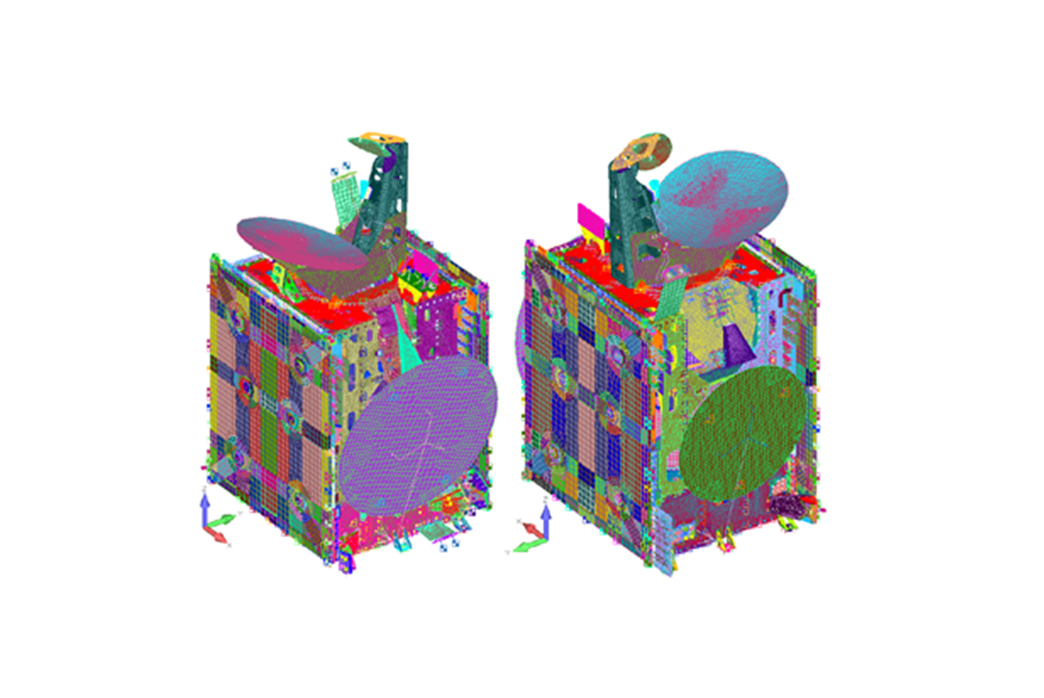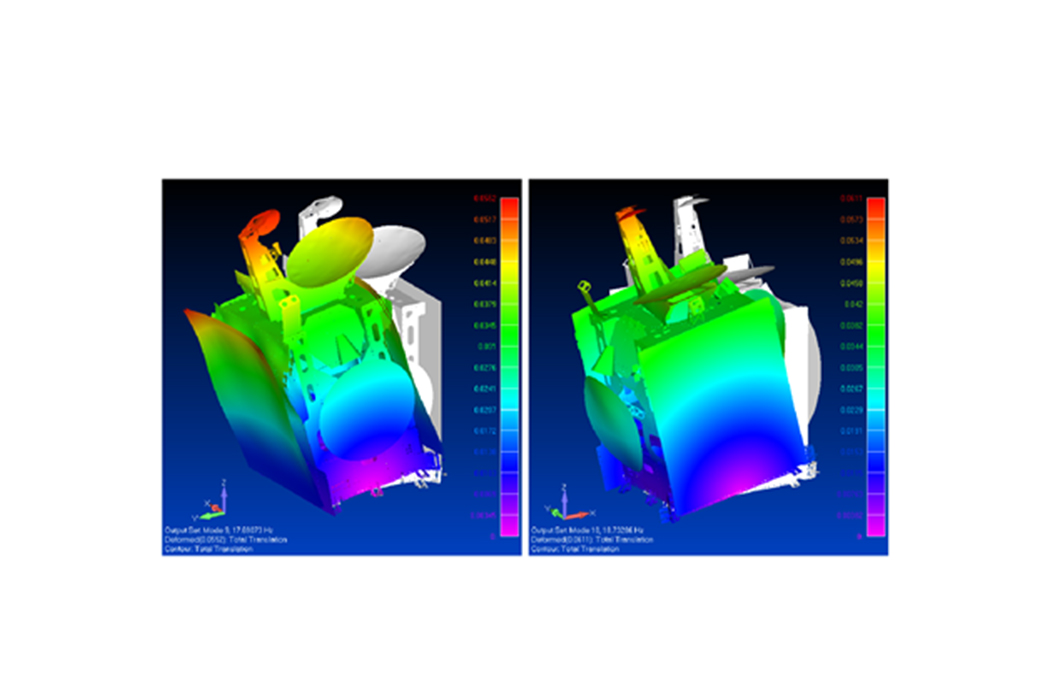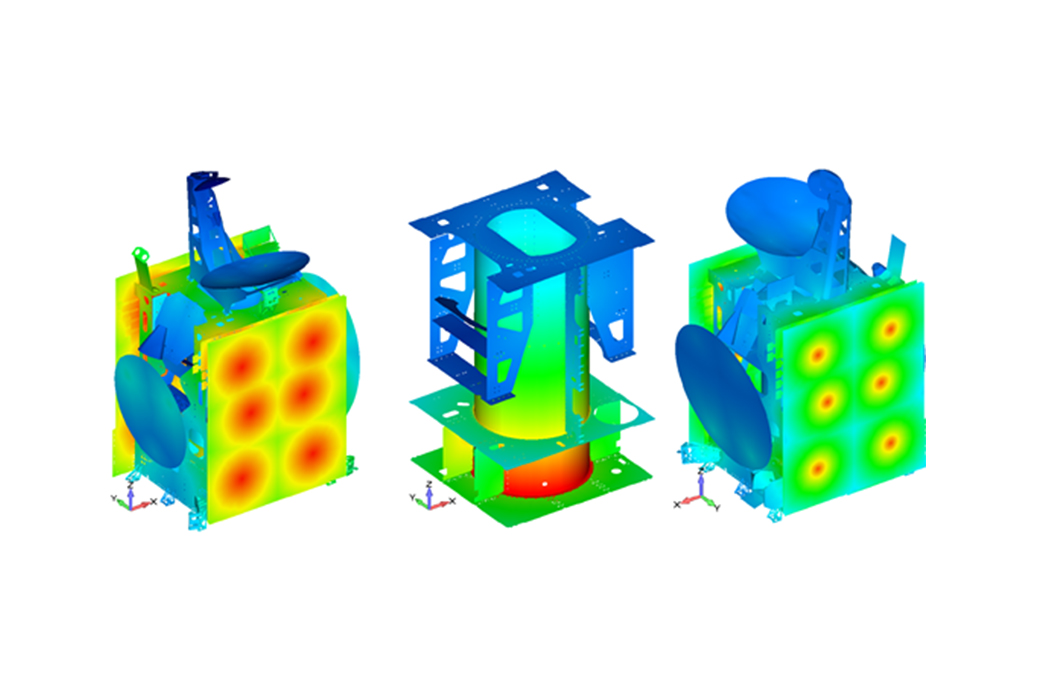STRUCTURAL ANALYSIS BY F.E.M.
INVENIO ENGINEERING S.R.L. has conducted several structural analysis as INVAP’s contractor from years 2012 to 2015 in relation with GEO and LEO satellites.
INVENIO ENGINEERING personnel has been involved in the following SATELLITE projects:
- ARSAT 1
- ARSAT 2
- SABIAMAR
Which yields more than 30,000 man-hours of FEM Analysis and modeling. A resume of structural analysis and FEM modeling is as follows:
FEM MODEL CHECKING
Large FEM model verification. Mesh quality checking, mesh accuracy and mesh correlation checking in accordance with mechanical drawings and specifications and international standards.
SATELLITES: ARSAT 2 (year 2012 to 2015)

FEM MODELING AND MESH GENERATION
Generation of finite element models (with FEMAP-NASTRAN) and meshes for satellite’s structure and components, including:
- Main structure.
- Intermediate platform modeling and meshing.
- Secondary structures (Antennas, thrusters, general payload).
- ARSAT 2 North and south panels model generation.
- FEM Models’ mesh modifications and improvements.
- FEM Model’s Load definitions (Launch loads or thermal loads).
- FEM Model’s documentation.
SATELLITES: ARSAT 2 (year 2012 to 2015) and SABIMAR (year 2015)
THERMOELASTIC ANALYSIS
Generation of FEM models for structural stress analysis due to non-uniform temperature distribution obtained from thermal-models considering different orbits positions and different satellite´s operational states.
Setting of a non-uniform temperature distribution to Satellite’s structure and further themo-elastic analysis to evaluate structure’s stresses, strains, bolted joint loads and bolts and inserts’ MS (Margin of Safety). Analysis and reporting.
SATELLITES: ARSAT 2 (year 2012 to 2015) and SABIAMAR (year 2015).
QUASI-STATC STRUCTURAL ANALYSIS
Generation of FEM models for structural stress analysis according to different dynamic and static accelerations developed during launch stages (for multiple launch vehicles).
SATELLITES: ARSAT 2 (year 2012 to 2015)
MARGIN OF SAFETY EVALUATION FOR LAMINATES
Intensive Margin of Safety (MS) calculations in laminates under several load scenarios. Analysis and reporting.
These margins evaluate
- Metallic Yields: valid for external and internal metallic facings (including reinforcement) and embedded aluminum or titanium.
- Honeycomb out-of-plane Shear: valid for intermediate material.
- Composite Ultimate: valid for external and internal facings (including reinforcement) on CFRP.
SATELLITES: ARSAT 2 (year 2012 to 2015) and SABIAMAR.
MARGIN OF SAFETY EVALUATION IN BOLTED JOINTS, INSERTS AND EDGE-CLAMPS
Margin of Safety (MS) in bolted joints under several load scenarios. Including bolts, inserts and edge-clamp. One-by-One analysis and reporting.
Considering different failure modes:
- Joint Separation
- Joint Slip
- Bolt tensile
- Bolt shear
- Bolt thread
- Nut thread
- Bolt combined scenario
SATELLITES: ARSAT 2 (year 2012 to 2015)
LOAD PATHWAYS DURING QUASI-STATIC EVENTS
Analysis and visualization of external forces pathways through central cylinder and North and South Shear Webs. Load vector-type visualization and reporting.
Internal forces assessment for launch configuration.
Comparison between load transfer in ARSAT-1 and ARSAT-2
SATELLITES: ARSAT 1 and ARSAT 2 (year 2012 to 2015)
MODAL ANALYSIS
Full satellite modal analysis. Modal masses, modal shapes and natural frequencies. Visualization and reporting.
Secondary structures (Antennas, thrusters, supports, tanks, etc) modal analysis. Modal masses, modal shapes and natural frequencies. Visualization and reporting.
SATELLITES: ARSAT 1, ARSAT 2 and SACOM1a (year 2012 to 2015)

SINE SWEEP ANALYSIS
System-level structural analysis under sinusoidal acceleration loads through a specified frequency range.
Component-level structural analysis under sinusoidal acceleration loads through a specified frequency range.
SATELLITES: ARSAT 2 (year 2012 to 2015)
POINTING ANALYSIS
Evaluation of translations and rotations for pointing purposes of some particular points of satellite structure under thermal loads in flight configuration. Analysis focused on the following components:
- IRES (both: IRES +X and IRES -X).
- Star Tracker (both: +Z and -Z).
- Ku FEED.
- Ku Band ADPM.
- C FEED.
- C Band ADPM.
- Gregorian Antenna.
SATELLITES: ARSAT 2 (year 2012 to 2015)
SHOCK ENVIRONMENT ANALYSIS
Generation shock maps on satellite’s PFM structure and determine equipment compatibility for different shock sources characterized by their Shock Response Spectrum (SRS). Shock Sources:
- Upper stage separation and Fairing jettisoning
- Drop Shock Test
- Solar Array Restrain-Release Mechanism
- Pyrotechnics on Reflectors
- Pyrotechnics on Pyro-Valves
Analysis of shock levels maps on satellite’s full model and assessment of equipment compatibility under different shock sources. Detailed shock maps on primary/secondary structure and critical equipment.
SATELLITES: ARSAT 2 (year 2014)

ACOUSTIC ENVIRONMENT ASSESSMENT
Panels vibroacoustic response estimation under acoustic environment of the launch vehicles.
SATELLITES: ARSAT 2 (year 2014) and SABIAMAR (year 2015)

